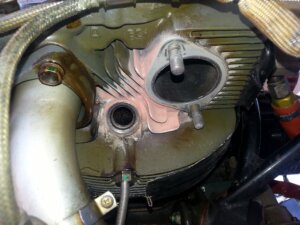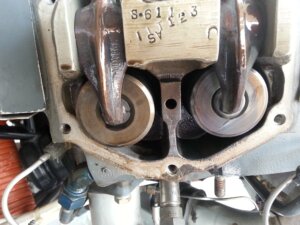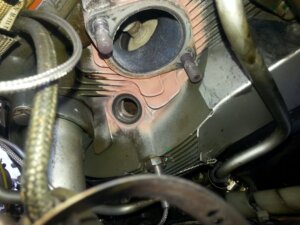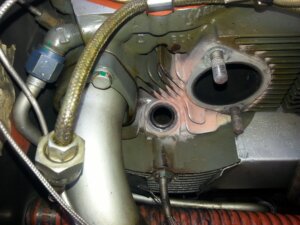Home › Forums › Maintenance of Grummans › Engine › Hot Cylinder Evidence
- This topic has 2 replies, 2 voices, and was last updated 8 years, 7 months ago by
 Roscoe Rosché.
Roscoe Rosché.
-
AuthorPosts
-
-
September 29, 2015 at 22:12 #2190
 Roscoe RoschéKeymaster
Roscoe RoschéKeymasterPart of the annual inspection checklist is to examine the cylinders of a plane for evidence of overheating. This can come from running too lean, baffle seals in poor repair, cooling system leaks, bad baffles, under-cylinders baffles undone or wired wrong, exit ramps that are colapsing or just too small of the engine heat generated (High compression STC, Powerflow, Electronic ignition – all which produce more power and thus, more heat.)
Notice the oil that is burning on the exhaust valve (right most valve) and causing it to be dark brown. In extreme cases it will be black and cooking up due to the oil actually burning and will lead to valve sticking. Valve wobble test will be 0, no wiggle at all. Very bad!
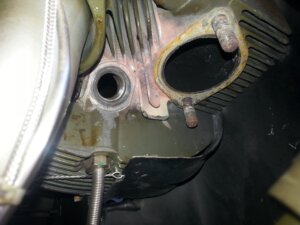
Compare this to a normal exhaust valve (300 hour engine) and a cylinder that only got hot occasionally.
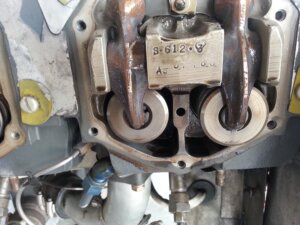
Cylinders that are getting hot may start to have helicoils fail and they will warp, or even come out when you remove a spark plug.
Engine management systems are so affordable today, that if you want to get the most out of your engine, you should install one. What you find may surprise you, even when operating the engine according to experts!
-
September 30, 2015 at 00:54 #2217
 John CotterSpectator
John CotterSpectatorWhile I had heard of the “pink” coloration of the cylinder due to overheat, and used to profess it as an indication of excessive temperature, I have never before seen such a graphic example of the color change due to extreme temperature. Thanks for an excellent photo.
-
October 1, 2015 at 20:26 #2424
 Roscoe RoschéKeymaster
Roscoe RoschéKeymasterAll four of these cylinders are from a AA5A/Cheetah with the 160HP STC, Powerflow Exhaust, and the Sensenich prop. The owner remarked how he had to step climb to keep the CHTs below 460-500. This engine from Florida was run very hot for awhile. Not a single occurance. He had deflector on the bottom of the cowling (aka Jimmy Candeletti Mod) and a blocking device installed behind the spinner to prevent the air from leaking out there.
We went over the baffles, sealed every little hole (they were some good ones in the front). When he left he was able to climb straight to 11,500 MSL. Cooling flow is critical.
-
-
AuthorPosts
- You must be logged in to reply to this topic.
